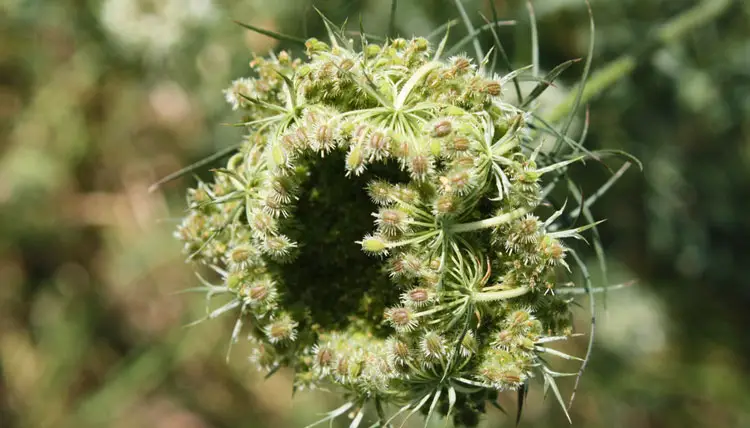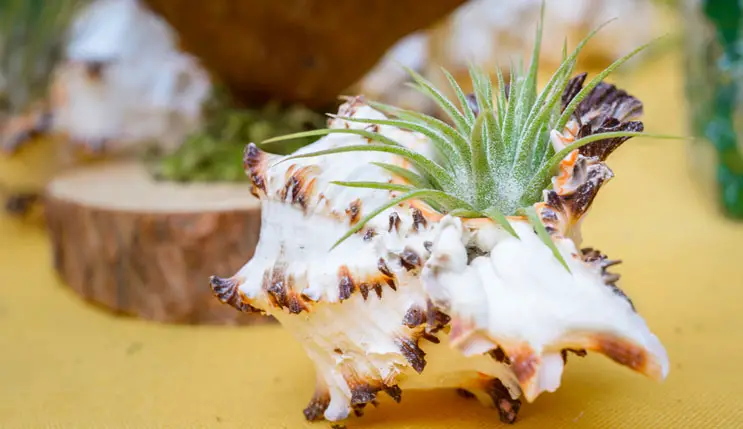Air Plant Pups: How to Propagate the Flowering Tillandsia

This post follows our research editorial guidelines.

The only thing better than one air plant (Tillandsia) is lots of air plants! They’re surprisingly easy to propagate, and do much of the hard work themselves. There’s a sting in the tail, though – you’ll only get pups off a dying plant. How does that even make sense?
Tillandsias can be grown from seeds, but it’s easiest to wait for pups. Wait patiently after blooms appear, and after a month or so baby plants called pups will develop. Once they are a third the size of the original, they can be safely cut away and treated as any other Tillandsia.

Table of Contents
When Should You Expect Your Air Plant to Have Pups?
Air plants are notably weird little guys. They’re fuzzy, with long skinny leaves like something out of a science fiction movie. Their life cycle is just as weird – a story of long waits and the ultimate sacrifice. Your air plant will only make pups after it has bloomed, and it blooms just once in its life. While it varies from species to species, most air plants must reach four or five years of age before they’re ready to bloom.
That’s not to say you’ll be waiting half a decade for your pups! Most commercial plants are approaching maturity, as it gives them the right size and hardiness to endure shipping and the rough conditions at stores. Prepare to wait a while, nonetheless – a year or two is not uncommon.
How To Create the Conditions for Air Plant Pups
Air plants can be divided into two broad groups – the xeric and the mesic. Know which one you have, and you can provide it with exactly what it needs to produce pups.
Xeric air plants hail from arid desert regions and have adaptations that hold water. They are covered in a thick silvery fuzz of special hairs called trichomes that collect the dew to keep them hydrated. They also harvest the dust from the wind, absorbing nutrients through their leaves.
Mesic air plants however evolved in more humid jungle environments. They are greener and less fluffy. They’ve evolved to need less light, with filtered and dappled sun the preferred option. They also like more water, echoing the ready rainfalls of the jungle.
In order to coax your Tillandsia into flowering, provide it with the best conditions possible, ideally close to those they’d experience in the wild. They need to feel at home. That’s bright and dry for a xeric, and humid for a mesic.
How To Separate Air Plant Pups
Once your air plant has flowered, wait for the parent plant to flag. It will start to dry out, the leaves becoming more crisp and papery. The color of the leaves will fade, too.
The reason? It’s focusing all its energy on seeds – and pups. In the wild, Tillandsias grow in thick groups, each plant expiring to make way for the next generation. Each dying air plant leaves us with one or more little replacements.
Once the process is complete, you can opt to just leave them together at the base of the expiring parent, a sort of morbid mulch that won’t harm the emerging pups at all. You can also carefully remove them from the parent and grow them separately.
Wait until the pups are at least a third the size of the parent. Cut them away gently with a clean knife, and allow the wound to dry out and callus over before you water again. This will prevent infections or rot setting attacking your plants.

How To Care for Air Plant Pups
While adorable, there’s no special treatment required for an air plant pup. As soon as they’re large enough to be removed from the parent plant they’ll start sharing the same requirements.
Start by assessing the light levels around your air plant. When grown indoors they need bright, indirect light all year round, at least six hours of it a day. A southern facing room is ideal, and if you have a kitchen or bathroom with a skylight even better. Xeric air plants like a little early morning direct sun, too, so let your pup bask in a sunbeam for an hour or so as the day begins.
They also like to be kept warm, between 65 and 85℉ (18 to 30°C) during the daytime, and will tolerate overnight temperature down to 50℉ (10°C) Younger plants are more vulnerable to sharp changes in temperature, so try and maintain an even temperature, free of cold drafts or blasts from heating systems.
Mesic air plants will also thrive with a bit of extra humidity. Consider growing them in glass terrariums of cloches, which not only look great but retain just a little bit of extra atmospheric moisture to support their early growth.
Watering Air Plant Pups
“The watering method and frequency for air plants looks much different than the typical houseplant,” writes Aaron Steil of Iowa State University’s Consumer Horticultural Extension Service. “Plants perform best with consistent and abundant moisture which they receive from the humid air and rains in their native habitat. With no soil and much drier conditions in the average home, providing that consistent moisture can be challenging”
He recommends a few approaches to keeping air plants, no matter what the size, properly hydrated. No matter what technique you use, you’ll will need watering roughly once or twice a week depending on your conditions.
Soaking Upside Down
The first method, and my personal favorite, is soaking your air plant pups. It’s a surefire way to make sure those miraculous leaves get a chance to suck up every drop they need.
Fill a small bowl with clean, lukewarm water. After all, babies hate cold baths! I also recommend you use filtered, distilled or even rain water if you can get it. Air plants are very sensitive to chemicals in tap water, especially when they are small.
After you’ve drawn your bath, dunk your baby and give it a good swish to clear any debris and air bubbles. Leave it to relax for fifteen minutes to half an hour, then place it on a towel or rack upside down to drain.
Tillandsias are technically a type of bromeliad, and their leaves hold water in their cup-like folds. Unlike bromeliads however such stagnant water will cause these arid terrain specialists to rot, so be sure to let them dry entirely before you place them back in their homes.

Misting
Misting is another option for small air plant pups. Mesic air plants especially enjoy this treatment.
Simply fill a plant mister with clean water and spritz the air plant until the leaves are damp to the touch. It’s much less fuss than soaking, and much quicker too.
Just be sure to flick away any excess water trapped between the leaves, and allow to dry thoroughly.
Rinsing
Probably the easiest way to water an air plant is to just up and rinse it under a faucet. All you need to do is get the water running and swish your air plant under the flow for a few minutes. Once done, you can put it off to the side to drain before returning it to its home.
While this is fine for adult air plants, I’d hesitate to use tap water on Tillandsias. As mentioned before, city water often has added chlorine and fluoride, and that’s before we get to the issue of mineral salts that lead to hard water in many locations.
Only rinse your Tillandsias if you know your tap water is of very good quality, or if you’ve installed an under counter water filtration device.
How Long Can Air Plants Go Without Water
Air plants are desert specialists. They’ll go for weeks, if not months, without a solid drink provided the conditions are right. If it’s cold enough and the humidity is high, they’ll just soldier on until the next chance for a drink.
But for most of us at home, I’d suggest you water at least once a week. Air plants have no root stock to draw from and no chance of rain or dew once we bring them indoors as houseplants. We owe it to these sweet little plants to make sure their needs are met.
It’s touching in its way that the last thing a Tillandsia does before it dies is produces a few darling little pups to keep us company. If we’re lucky, we growers need never be without one of these strange, delightful little plants.
